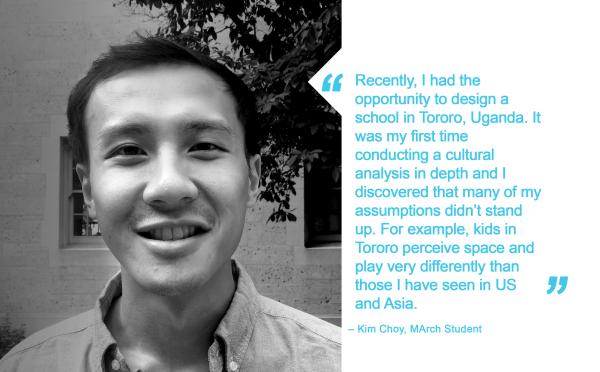Kim Choy, Student

In this post, we speak with Kim Choy. After obtaining his Bachelor of Commerce specializing in Finance from the University of British Columbia, Kim moved to Austin to pursue a Master of Architecture degree.
In the School, what degree are you seeking? What year are you in?
I am currently in the Master of Architecture First-Professional program, in the second semester of my first year.
In what ways have you incorporated diversity and equity issues as part of your educational experience?
Living in a border state (Texas) has exposed me to new cultures, which I had not experienced growing up in Asia and the Pacific Northwest. This proximity encourages me to keep an open mind and to learn more about different ways of living. In my day-to-day routine, I try to remain mindful and seek to understand the various cultures of my colleagues.
Last semester, I had the opportunity to design a school in Tororo, Uganda. It was my first time conducting a cultural analysis in depth and I discovered that many of my assumptions didn’t stand up against testing. For example, I found that the children in Tororo perceive space and play very differently to children I have interacted with in Asia and the United States. But the biggest lesson I learned was never to make assumptions incorporating diversity and equity issues is to never assume.
What does diversity mean to you?
Diversity means an environment, which facilitates a plethora of different ideas and thoughts and transcends physical and intangible barriers such as color, age, culture, habits, viewpoints, etc.
Can you describe the sense of community at the School?
Right now, the graduate student population is relatively homogenous. Having said that, I believe that students here are very friendly and are very proactive in creating an environment that helps everyone learn. My direct peers are always very interested in learning more about my background, experiences, and culture. The community here is a hotbed of ideas and conversation.
What are your aspirations –big or small– for the future?
My aspiration for the future is to help solve environmental, economical, and social problems through the design of space and systems. It brings me joy to work on meaningful problems. On a smaller scale, I want to know how to get around and where to go in Austin without Google!

